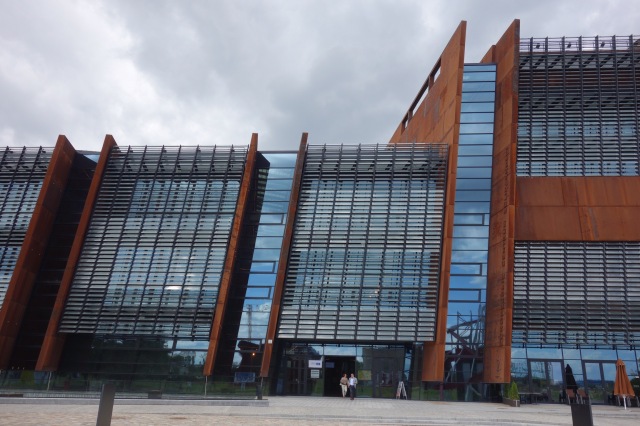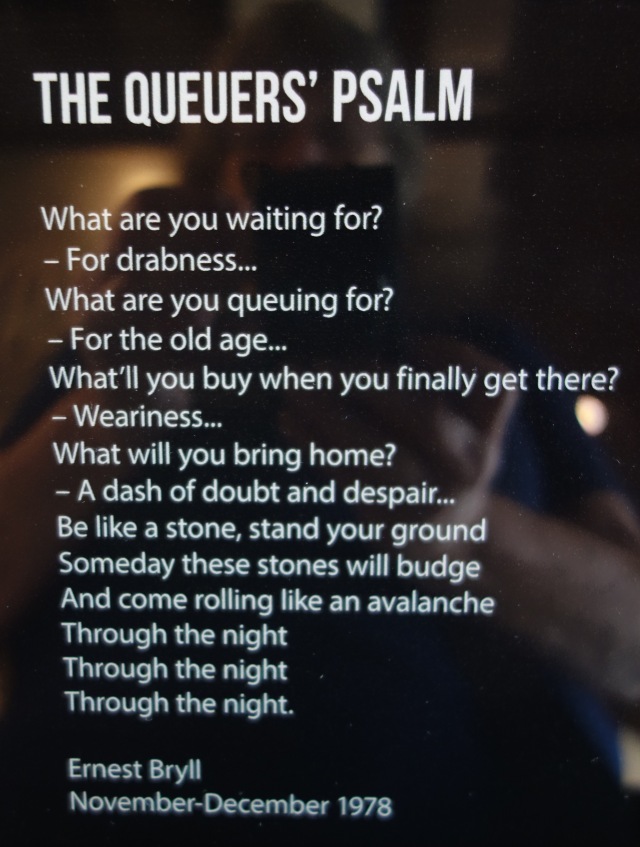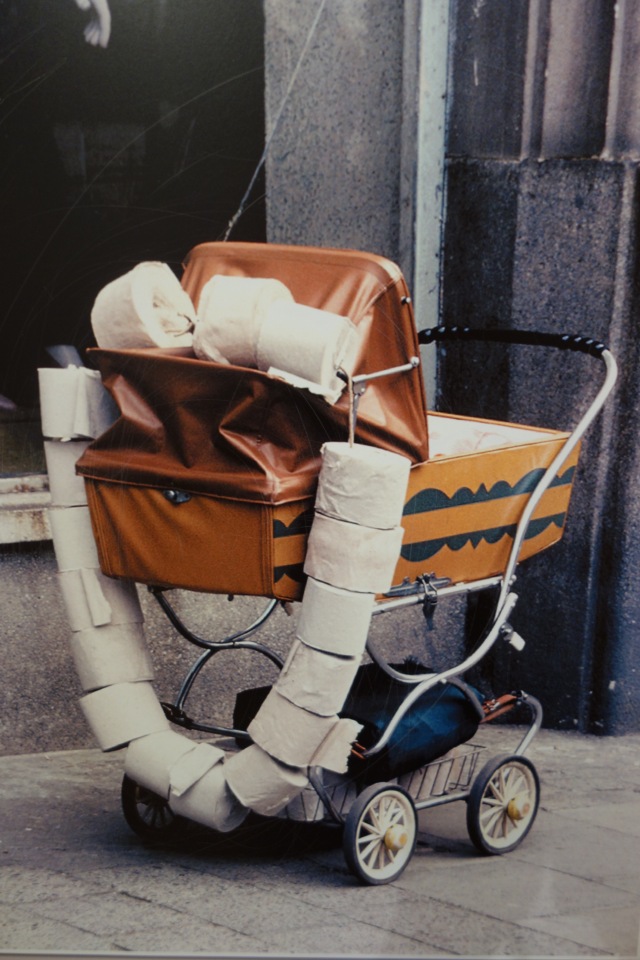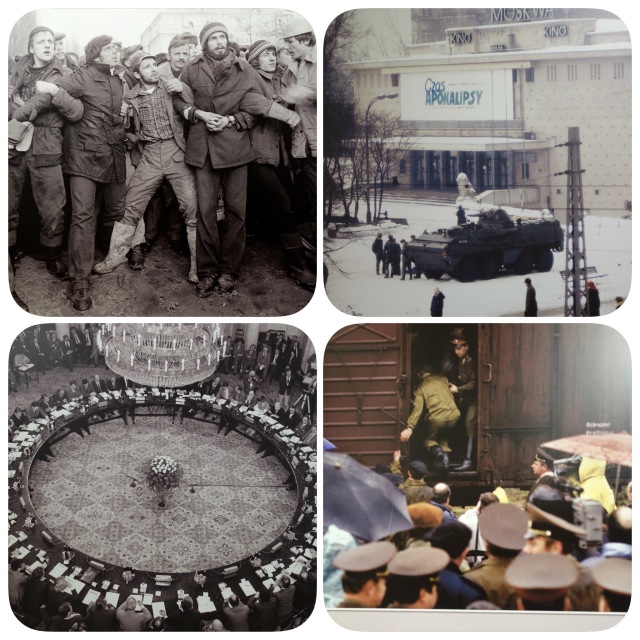It was Solidarity that drew me to Gdańsk. I feel oddly emotional whenever I see that red and white Solidarność symbol, a reminder of the concerted peaceful action of 10 million ordinary people throughout Poland in the 1980s. It began with a strike at the Gdańsk shipyards under the leadership of Lech Walęsa, a longstanding hero of mine.
So a visit to the European Solidarity Centre is a must.
Monument of the fallen shipyard workers
I’m greeted by panels in a number of languages with small sculpted figures emerging from the concrete. Towering into the sky is the monument, three pillars against the grey clouds. A nearby statue of a man with hands shielding his face fronts a wall of remembrances. Several hundred workers were killed and a lot more injured as the communist regime tried to eradicate the strikes.
The building
The museum building is designed to give the impression of walls cracking and tilting, and is covered in rust-coloured sheet metal reminiscent of a ship’s hull. It stands at the entrance to the shipyards where strikes began over food prices and the sacking of Anna Walentynowicz for union activities.
Inside there is glass, timber and plantings. This museum won the 2016 Council of Europe museum prize and the trophy, designed by Joan Miró in 1968, stands proudly in the vast entrance space.

The exhibition
There are so many thing in the exhibition that moved me: an old metal locker with worn workman’s clothes hanging in it; a ceiling of workers helmets with employee numbers stencilled on them; a bullet-riddled jacket and a heavy metal hospital door with bullet holes in it; a cell such as the one protesters were imprisoned in; a newspaper article showing Walęsa as a family man with his wife and young child; mugshots of strikers; film of crowds listening to speakers.
The events of 1980 are given their background: the strike in Poznań in 1956; the Prague Spring of 1968; the March 1968 protests in Warsaw when the performance of a Mickiewicz play was banned; the food shortages and queuing for scarce resources in the late 1970s (when my son-in-law was a child); then the sacking of Anna Walentynowicz which precipitated the strike. I only scraped the surface of the information offered: I’ll be back.
Rambling around the semi-wasteland outside the museum, I come across the building where the 1980 August Accords were signed, establishing Solidarność as an independent self-governing trade union. Inside, a series of panels present the life of Anna Walentynowicz including her arguments with Walęsa: she accused him of passivity, failure to listen to other people’s opinions and submissiveness towards the authorities. Once again my simple-minded hero worship is challenged, although I can feel a new bout coming on, with Walentynowicz as its object. The photo shows her during the strike in the Lenin Shipyard in 1980, just before her reinstatement.
A number of other photos catch my attention. The men with linked arms are trying to hold back those who don’t want to be involved in strike action. The tank is outside the Moskwa Kino during martial law: the authorities saw the screening of “Apocalypse now” as a subversive act. The round table is the site of 1989 discussions which led to elections where 35% of seats were reserved for deputies independent of communist authorities. The final photo shows the last Russian soldiers leaving Poland in 1993.
As I walk back towards the museum thinking about the events I’ve just seen unfold, I come across the colours of Solidarność embodied in white daisies and red poppies.















I’m afraid to say that I was a very new mum in 1980 and I only have hazy memories of these times. It must have been great for you to finally see this place as Walesa has been a hero to you all these years. Thanks for a very interesting article Meg.
LikeLike
I wasn’t present at the time for similar reasons – three young kids and semi-roughing it in the bush. I can’t remember when exactly I encountered the story.
LikeLike
Heroic indeed. Thank you, Meg, for all these ‘in the field’ insights. Sometimes a museum comes along that hits all the right spots. This looks like one of them. A true memorial.
LikeLike
It also filled in a bit more Polish history – a patchwork for me at the moment with empty places waiting to be filled.
LikeLiked by 1 person
Your commitment to discover impresses me. Ao a big thank you for also passing on the findings.
LikeLike
Oooh, lump in the throat stuff, Meg! I love those sculptures, trapped in the concrete. And the hands, and the two ‘dangling’ at the window. I was looking over your shoulder the whole time. Beautifully penned and your warmth is ever present. 🙂
LikeLike
I’d rather you by my side or poking around seeing things I’ve missed. But thank you for looking over my shoulder. And thank you too for “beautifully penned.” I spent a long time writing this one.
LikeLike
I could tell. 🙂 When your emotions are involved but you want to represent it properly. You did 🙂 And presumably you found ‘the hotel’ 🙂
LikeLike
I remember this very clearly too, so was fascinated by your post. The monument is quite ugly (not a criticism) and I love the way it thrusts thought the concrete slabs as if it’s had to force its way out. The figures are very moving. I would find this museum really interesting.
LikeLike
I’m really enjoying the responses to this post, and the insight into other people’s intersection with 1980 events.
LikeLiked by 1 person
In your photos you convey the very raw sense of the struggle memorialised in the contents of the museum, the thrusting monument and haunting sculptures in this city. Just as it should be, as that is how it was. Living in Australia I remember following those events in trepidation, marvelling at the courage of Solidarity members in the face of the might of the USSR but never daring to dream that their movement could achieve its aims in Poland let alone the whole of Eastern Europe. I loved your final photo with poppies and daisies in the national colours of Poland.
LikeLike
I wasn’t aware at the time, and I’m always in awe of the way you are always somehow present as history unfolds, notably China and now Poland. The struggle affected so many people in so many ways, not least the lives of my Polish family – and even the fact that I have one!
LikeLike
My own life at that time was tied up with apartheid in South Africa and not much news of the outside world got through to us. Television was not available until 1976 and we didn’t have a set for years, and even the Falkland War was hardly mentioned, but of course once I returned to the UK I learned about Lech Walęsa. Then as I lived in South Yorkshire, I was bang in the middle of the miners’ strikes. Turbulent times in the world.
I find the monument ugly, but your focus on the details beautiful and thank you for bringing the history of the time to me. Another well-crafted post.
LikeLike
It hadn’t occurred to me properly that you were in South Africa under apartheid. We should write our life stories in the shadow of turbulent times, you far more immediately than I in Australia. Thank you for “well-crafted”: I always appreciate such comments when I’ve spent time writing and rewriting.
LikeLiked by 1 person
Oh, I was one of those who cheered Lech Wałęsa along from halfway across the world! We keenly followed the Solidarity movement via radio and Time magazine. The sculpture exhibits are poignant. I wouldn’t miss this for anything if I ever visit Poland. Thank you for sharing Meg.
LikeLike
International coverage of Solidarity was pretty thorough. There was a whole rack of newspaper articles in a variety of languages, and a collage of magazine covers. I’m really enjoying hearing about its personal impact on fellow-bloggers.
LikeLike
I must find a way of getting to Gdansk and seeing this museum…..I think I told you about my train journey from Vienna in 1982 and being handed a Solidarity leaflet (which of course I didn’t keep, not knowing the significance of it….)
LikeLike
I’m glad you retold this story. It adds to the great collection of “During Solidarity I was …” insights in the comments. You must be home to be posting. I’m sad to be in a Warsaw without you, and very glad we got a chance to meet and spend a bit of time yacking and snapping!
LikeLiked by 1 person
Meg, I am so pleased to have met you after all our blog conversations, and was sad to part… The yakking and snapping was a wonderful experience, and I felt very happy to have you and Vivi to support me in that heat! Now I’m back to harsh reality here, and not relishing it
LikeLike
I hope reality is not quite as harsh as you fear.
LikeLiked by 1 person
And I hope you are right….. I can be a real worrier, unnecessarily at times. And worrying is futile, I know that, but still do it
LikeLike
If you ever learn how not to, let me know and patent it!
LikeLiked by 1 person
😀
LikeLike